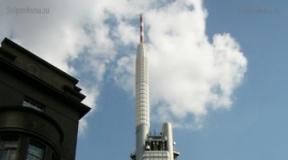Bromhexine instructions for use of the tablet 0.008 g. Bromhexine - instructions for use. Special instructions and precautions
10 pieces. - contour cell packings.
20 pcs. - contour cell packings.
30 pcs. - banks.
40 pcs. - banks.
50 pcs. - contour cell packings.
pharmachologic effect
Mucolytic agent with expectorant action. Reduces the viscosity of bronchial secretions by depolarizing the acidic polysaccharides contained in it and stimulating the secretory cells of the bronchial mucosa, which produce secretions containing neutral polysaccharides. It is believed that bromhexine promotes the formation of a surfactant.
Pharmacokinetics
Bromhexine is rapidly absorbed from the gastrointestinal tract and undergoes intensive metabolism during the "first pass" through the liver. Bioavailability is about 20%. In healthy patients, C max in is determined after 1 hour.
It is widely distributed in body tissues. About 85-90% is excreted in the urine, mainly in the form of metabolites. The metabolite of bromhexine is.
Plasma protein binding of bromhexine is high. T 1/2 in the terminal phase is about 12 hours.
Bromhexine penetrates the BBB. In small quantities, it crosses the placental barrier.
Only small amounts are excreted in the urine with a T 1/2 of 6.5 h.
The clearance of bromhexine or its metabolites may decrease in patients with severe hepatic and renal impairment.
Indications
Diseases respiratory tract accompanied by the formation of a viscous secretion that is difficult to separate: tracheobronchitis, Chronical bronchitis with a broncho-obstructive component, cystic fibrosis, chronic pneumonia.
Contraindications
Hypersensitivity to bromhexine.
Dosage
Inside for adults and children over 10 years old - 8 mg 3-4 times / day. Children under the age of 2 years - 2 mg 3 times / day; at the age of 2 to 6 years - 4 mg 3 times / day; at the age of 6 to 10 years - 6-8 mg 3 times / day. If necessary, the dose can be increased for adults up to 16 mg 4 times / day, for children up to 16 mg 2 times / day.
In the form of inhalation for adults - 8 mg each, children over 10 years old - 4 mg each, at the age of 6-10 years - 2 mg each. At the age of 6 years - used in doses up to 2 mg. Inhalations are carried out 2 times / day.
The therapeutic effect may appear on the 4th-6th day of treatment.
Side effects
From the side digestive system: dyspeptic phenomena, a transient increase in the activity of hepatic transaminases in the blood serum.
From the side of the central nervous system:, dizziness.
Dermatological reactions: increased sweating, skin rash.
From the respiratory system: cough, bronchospasm.
Drug interactions
During lactation, bromhexine is used in cases where the intended benefit to the mother outweighs the potential risk to the fetus or child.Bromhexine
International non-proprietary name
Bromhexine
Dosage form
Tablets 0.008 g
Composition
One tablet contains
active substance: bromhexine hydrochloride - 0.008 g
Excipients: sucrose (white sugar), lactose monohydrate
(milk sugar), calcium stearate monohydrate, potato starch
Description
Tablets white, flat-cylindrical shape, with beveled
Pharmacotherapeutic group
Expectorant drugs. Mucolytics. Bromhexine.
ATX code R05СB02
Pharmacological properties
Pharmacokinetics
When taken orally, almost completely (99%) is absorbed into gastrointestinal tract within 30 minutes. Bioavailability - low (effect
"Primary passage" through the liver). Penetrates the placental and blood-brain barriers.
In the liver, it undergoes demethylation and oxidation, metabolized to pharmacologically active ambroxol. The half-life is 15 hours (due to slow reverse diffusion from tissues). It is excreted by the kidneys. With chronic renal failure the excretion of metabolites is disturbed. May cumulate with repeated use.
Pharmacodynamics
Mucolytic (secretolytic) agent, has an expectorant and weak antitussive effect. Reduces the viscosity of sputum (depolymerizes mucoprotein and mucopolysaccharide fibers, increases the serous component of bronchial secretions); activates ciliated epithelium, increases volume and improves sputum discharge. Stimulates the production of endogenous surfactant, which ensures the stability of alveolar cells during respiration. The effect appears in 2-5 days from the start of treatment.
Indications for use
Secretolytic therapy for acute and chronic diseases of the bronchi and lungs, accompanied by difficult to separate sputum
Pre- and postoperative period (sanitation of the bronchial tree in the preoperative period and during medical and diagnostic intrabronchial manipulations, prevention of the accumulation of thick viscous sputum in the bronchi after surgery)
Method of administration and dosage
Inside for adults and children over 14 years old - 8-16 mg 3-4 times a day.
Children aged 6-14 years - 8 mg 3 times a day.
If necessary, the dose can be increased for adults up to 16 mg 4 times a day.
Patients with renal insufficiency are prescribed smaller doses or increase the interval between doses of the drug.
Side effects
Sometimes
Increased body temperature
Hypersensitivity reactions (skin rash, angioedema, respiratory distress, itching, urticaria)
Nausea, abdominal pain, vomiting, diarrhea
Very rarely
Aggravation peptic ulcer stomach and duodenum
Increased activity of "hepatic" transaminases
Anaphylactic reactions, including anaphylactic shock
Development of severe skin reactions such as Stevens-Johnson syndrome and Lyell's syndrome
In case of hypersensitivity reactions, anaphylactic reactions or the appearance of any unusual changes on the skin and mucous membranes, you should immediately stop taking Bromhexine and consult a doctor.
Contraindications
Hypersensitivity to bromhexine or one of the other components of the drug
Galactose or fructose intolerance, glucose-galactose malabsorption syndrome, sucrase-isomaltase deficiency
Peptic ulcer of the stomach
Pregnancy (I trimester) and lactation period
Children under 6 years of age
Carefully
Renal and / or hepatic impairment
Diseases of the bronchi, accompanied by excessive accumulation of secretions
History of gastric bleeding
Pregnancy period (II and III trimester)
Drug interactions
Do not appoint concomitantly with medicines suppressing the cough center (including codeine), since this makes it difficult for the liquefied sputum to pass (accumulation of bronchial secretions in the airways).
Incompatible with alkaline solutions.
Bromhexine promotes the penetration of antibiotics (amoxicillin, erythromycin, cephalexin, oxytetracycline), sulfa drugs into bronchial secretions in the first 4-5 days of antimicrobial therapy.
special instructions
During treatment, it is necessary to take a sufficient amount of liquid, which increases the expectorant effect of bromhexine.
In children, treatment should be combined with postural drainage or vibration massage chest, facilitating the removal of secretions from the bronchi.
Pregnancy and lactation
In the first trimester of pregnancy, the drug is contraindicated. During pregnancy (II and III trimester), bromhexine is prescribed only when the intended benefit to the mother outweighs the potential risk to the fetus.
Bromhexine crosses the placental barrier, therefore, if necessary, use the drug during lactation breast-feeding must stop.
Features of the effect of the drug on the ability to drive a vehicle or potentially dangerous mechanisms
During the period of taking the drug, a slight weakening of attention is possible, as a result of which it is necessary to refrain from administration vehicles and doing other potentially dangerous species activities requiring increased concentration of attention and speed of psychomotor reactions.
Overdose
Pharmacological properties:
Pharmacodynamics
Mucolytic agent with expectorant action. Reduces the viscosity of bronchial secretions by depolarizing the acidic polysaccharides contained in it and stimulating the secretory cells of the bronchial mucosa, which produce secretions containing neutral polysaccharides. It is believed that bromhexine promotes the formation of a surfactant.
Pharmacokinetics
Bromhexine is rapidly absorbed from the gastrointestinal tract and undergoes intensive metabolism during the "first pass" through the liver. Bioavailability is about 20%. In healthy patients, C max in plasma is determined after 1 hour.
It is widely distributed in body tissues. About 85-90% is excreted in the urine, mainly in the form of metabolites. The metabolite of bromhexine is ambroxol.
Plasma protein binding of bromhexine is high. T 1/2 in the terminal phase is about 12 hours.
Bromhexine penetrates the BBB. In small quantities, it crosses the placental barrier.
Only small amounts are excreted in the urine with a T 1/2 of 6.5 h.
The clearance of bromhexine or its metabolites may decrease in patients with severe hepatic and renal impairment.
Indications for use:
Diseases of the respiratory tract, accompanied by the formation of a viscous secretion that is difficult to separate: tracheobronchitis, chronic bronchitis with a broncho-obstructive component, bronchial asthma, cystic fibrosis, chronic pneumonia.
Refers to diseases:
- Asthma
- Bronchitis
- Cystic fibrosis
- Pneumonia
- Tracheitis
- Tracheobronchitis
Contraindications:
Hypersensitivity to bromhexine.
Method of administration and dosage:
Inside for adults and children over 10 years old - 8 mg 3-4 times / day. Children under the age of 2 years - 2 mg 3 times / day; at the age of 2 to 6 years - 4 mg 3 times / day; at the age of 6 to 10 years - 6-8 mg 3 times / day. If necessary, the dose can be increased for adults up to 16 mg 4 times / day, for children up to 16 mg 2 times / day.
In the form of inhalation for adults - 8 mg each, children over 10 years old - 4 mg each, at the age of 6-10 years - 2 mg each. At the age of 6 years - used in doses up to 2 mg. Inhalations are carried out 2 times / day.
The therapeutic effect may appear on the 4th-6th day of treatment.
Side effect:
From the digestive system: dyspeptic phenomena, a transient increase in the activity of hepatic transaminases in the blood serum.
From the side of the central nervous system: headache, dizziness.
Dermatological reactions: increased sweating, skin rash.
From the respiratory system: cough, bronchospasm.
Application during pregnancy and lactation:
During pregnancy and lactation, bromhexine is used in cases where the intended benefit to the mother outweighs the potential risk to the fetus or child.
Interaction with other medicinal products:
Bromhexine is incompatible with alkaline solutions.
Special instructions and precautions:
With gastric ulcer, as well as with indications of gastric bleeding in the anamnesis, bromhexine should be used under the supervision of a physician.
Use with caution in patients with bronchial asthma.
Bromhexine is not used simultaneously with drugs containing codeine, because this makes it difficult to cough up the liquefied sputum.
Used as part of combination drugs vegetable origin with essential oils(including with eucalyptus oil, anise oil, peppermint oil, menthol).
Mucolytic, expectorant. Acute and chronic diseases bronchi and lungs with impaired sputum discharge. adults and children over 14 years old? 10-20 ml (8-16 mg) 3 r per day; children under 14 years of age and patients weighing less than 50 kg? 5-10 ml (8 mg) 3 r per day; children under 6 years old? 2.5-5 ml (4 mg) 3 r per day.
Mucolytic agent with expectorant action. Reduces the viscosity of bronchial secretions by depolarizing the acidic polysaccharides contained in it and stimulating the secretory cells of the bronchial mucosa, which produce secretions containing neutral polysaccharides. It is believed that bromhexine promotes the formation of a surfactant.
Diseases of the respiratory tract, accompanied by the formation of a viscous secretion that is difficult to separate: tracheobronchitis, chronic bronchitis with a broncho-obstructive component, bronchial asthma, cystic fibrosis, chronic pneumonia.
Inside for adults and children over 10 years old - 8 mg 3-4 times / day. Children under the age of 2 years - 2 mg 3 times / day; at the age of 2 to 6 years - 4 mg 3 times / day; at the age of 6 to 10 years - 6-8 mg 3 times / day. If necessary, the dose can be increased for adults up to 16 mg 4 times / day, for children up to 16 mg 2 times / day. In the form of inhalation for adults - 8 mg each, children over 10 years old - 4 mg each, at the age of 6-10 years - 2 mg each. At the age of 6 years - used in doses up to 2 mg. Inhalations are carried out 2 times / day. The therapeutic effect may appear on the 4th-6th day of treatment. Parenteral administration is recommended for the treatment of severe cases as well as postoperative period to prevent the accumulation of thick phlegm in the bronchi. Enter 2 mg sc, intramuscularly or intravenously 2-3 times / day slowly for 2-3 minutes.
From the digestive system: dyspeptic phenomena, a transient increase in the activity of hepatic transaminases in the blood serum. From the side of the central nervous system: headache, dizziness. Dermatological reactions: increased sweating, skin rash. From the respiratory system: cough, bronchospasm.
Hypersensitivity to bromhexine.
In case of gastric ulcer, as well as if there is a history of gastric bleeding, bromhexine should be used under the supervision of a physician. Use with caution in patients with bronchial asthma. Bromhexine is not used simultaneously with drugs containing codeine, because this makes it difficult to cough up the liquefied sputum. It is used as part of combined herbal preparations with essential oils (including with eucalyptus oil, anise oil, peppermint oil, menthol).
Bromhexine is incompatible with alkaline solutions.
The site provides background information for informational purposes only. Diagnosis and treatment of diseases must be carried out under the supervision of a specialist. All drugs have contraindications. A specialist consultation is required!
Registration number: P N015546 / 01 from 08.05.09Trade name of the drug: Bromhexine 8 Berlin-Chemie
International non-proprietary name : Bromhexine
Dosage form: dragee
Composition for 1 tablet:
Core:
Active substance: bromhexine hydrochloride - 8,000 mg.
Excipients: lactose monohydrate - 34,400 mg, corn starch - 14, 600 mg, gelatin - 1,800 mg, colloidal silicon dioxide - 0,600 mg, magnesium stearate - 0,600 mg;
Shell: sucrose - 27.704 mg, calcium carbonate - 4.326 mg, magnesium carbonate - 1.507 mg, talc - 1.750 mg, macrogol 6000 - 1.750 mg, glucose syrup - 1.639 mg, titanium dioxide (E171) - 1.166 mg, povidone K25 - 0.243 mg, carnauba wax - 0.012 mg, quinoline yellow (E 104) - 0.146 mg.
Description: yellow to greenish-yellow dragee, biconvex with an almost white core.
Pharmacotherapeutic group: Expectorant mucolytic.
ATX: R05CB02.
Pharmacological properties
PharmacodynamicsBromhexine 8 Berlin-Chemie has a mucolytic (secretolytic) and expectorant (secretomotor) effect, as well as a weak antitussive effect. Reduces the viscosity of sputum, activates the ciliated epithelium, increases the volume of sputum and improves its discharge. Stimulates the production of endogenous surfactant, which ensures the stability of alveolar cells during respiration. The effect appears in 2-5 days from the start of treatment.
Pharmacokinetics
When taken orally, it is almost completely absorbed (99%) in the gastrointestinal tract (GIT) within 30 minutes. Bioavailability is about 80%. Binds to plasma proteins by 99%. Penetrates the placental and blood-brain barriers. Penetrates into breast milk... In the liver, it undergoes demethylation and oxidation, metabolized to ambroxol. The half-life is 15 hours (due to slow reverse diffusion from tissues). It is excreted by the kidneys in the form of metabolites. In chronic renal failure (CRF), the release of metabolites is impaired. May cumulate with repeated use.
Indications for use
- acute and chronic bronchopulmonary diseases, accompanied by the formation of sputum of high viscosity (bronchial asthma, pneumonia, tracheobronchitis, obstructive bronchitis, bronchiectasis, pulmonary emphysema, cystic fibrosis, tuberculosis, pneumoconiosis).Contraindications
- hypersensitivity to bromhexine and other components of the drug;- lactase deficiency, lactose intolerance, glucose-galactose malabsorption;
- stomach ulcer and duodenum(in the stage of exacerbation);
- pregnancy (I trimester);
- childhood up to 6 years old.
Carefully
- renal and / or hepatic impairment;- in violation of bronchial motility, accompanied by excessive accumulation of secretions;
- with a tendency to gastric bleeding history.
Application during pregnancy and lactation
The use of the drug during pregnancy is possible only if the intended benefit to the mother exceeds possible risk for the fetus. The use of the drug during lactation is contraindicated.Method of administration and dosage
The drug is administered orally, after meals, without chewing, drinking plenty of fluids.For adults and adolescents over 14 years old: 3 times a day for 1-2 pills (24-48 mg / day).
Children from 6 to 14 years old, as well as patients weighing less than 50 kg: take 3 times a day for 1 tablet (24 mg / day).
In case of impaired renal and / or liver function, the intervals between doses should be increased, or the dose should be reduced. On this issue, you need to consult with your doctor.
The duration of use is set on an individual basis and depends on the indications and course of the disease. If you need to take more than 4-5 days, a doctor's consultation is required.
Side effect
Usually Bromhexine 8 Berlin-Chemie is well tolerated.In rare cases, nausea, vomiting, dyspeptic symptoms, exacerbation of gastric ulcer and duodenal ulcer, allergic reactions (skin rash, rhinitis, edema), shortness of breath, fever and chills are possible.
Rarely ( Headache, dizziness.
Increased activity of "hepatic" transaminases (extremely rare).
With all forms allergic reactions you must stop taking this drug and inform your doctor about it.
Overdose
The life-threatening consequences of an overdose with Bromhexine 8 Berlin-Chemie are unknown.Possible following symptoms: nausea, vomiting, diarrhea, dyspeptic disorders.
Treatment: artificial vomiting, gastric lavage in the first 1-2 hours after taking the drug.
Because of high degree protein binding and high volume of distribution elimination of bromhexine during hemodialysis or forced diuresis does not occur.
Interaction with other medicinal products
Bromhexine is not prescribed concurrently with drugs that suppress the cough center (including those containing codeine), because this makes it difficult to evacuate the liquefied sputum.Bromhexine promotes the penetration of antibiotics (erythromycin, cephalexin, oxytetracycline, ampicillin, amoxicillin) into the bronchial secretions in the first 4-5 days of antimicrobial therapy.
Not compatible with alkaline solutions.
special instructions
In cases of impaired bronchial motility or with a significant amount of sputum secreted, the use of Bromhexin 8 Berlin-Chemie requires caution, due to the risk of delayed secretion in the airways.In the course of treatment, it is recommended to consume a sufficient amount of liquid, which increases the secretolytic effect of bromhexine.
In severe renal failure, it is necessary to take into account the possibility of cumulation of metabolites formed in the liver.
In children, treatment should be combined with postural drainage or vibration massage of the chest, facilitating the removal of secretions from the bronchi.
The effect of the drug on the ability to drive vehicles and control mechanisms
During the period of treatment, care must be taken when driving vehicles and engaging in other potentially hazardous activities that require increased concentration of attention and speed of psychomotor reactions.
Release form
Dragee 8 mg.25 pills in a blister strip packaging (PVC blister / aluminum foil).
1 blister with instructions for use in a cardboard box.
Storage conditions
Store the medicinal product at a temperature not exceeding 25 ° C.Keep the medicinal product out of the reach of children!
Shelf life
5 yearsDo not use after the expiry date stated on the package!
Terms of dispensing from pharmacies
Over the counter.Marketing Authorization Holder
Berlin-Chemie / Menarini Pharma GmbH, Germany
Company manufacturer
Berlin-Chemie AG
Tempelhofer Veg 83
12347 Berlin, Germany
Complaints address:
123317, Moscow, Presnenskaya embankment, building 10, BC "Tower on the Embankment", Block B.
* The information has been corrected at the request of the manufacturer Berlin-Chemie / A. Menarini



















